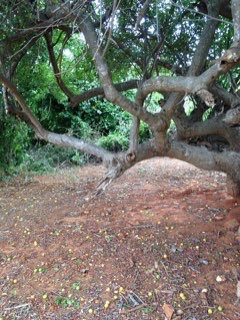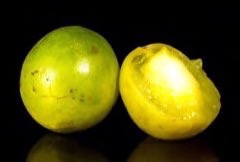 |
|
alvaroboliveira wikimedia.org |
 |
| Rodrigo.Argenton, wikimedia.org |
Translate this page:
Summary
Spondias tuberosa, also known as Imbu or Brazil Plum, is a slow-growing tree native to northeast Brazil. It has a low, flat top, wide and highly dense crown and it reaches a height of about 6 m upon maturity. The bark is smooth and gray. The leaves are compound, with each leaf comprising 3-7 thin leaflets. The flowers are white, fragrant and located at the ends of branches. The fruits are round, light yellow to red, and covered with leathery shell. The flesh is succulent, with a pleasant subacid flavor. It is edible, usually eaten raw or cooked. The wood is used for internal work, crates, boxes and paper pulp. The plant has no medicinal uses. Plants are grown from seed or cuttings.
Physical Characteristics

 Spondias tuberosa is a deciduous Tree growing to 6 m (19ft) by 8 m (26ft) at a slow rate.
Spondias tuberosa is a deciduous Tree growing to 6 m (19ft) by 8 m (26ft) at a slow rate.
See above for USDA hardiness. It is hardy to UK zone 10. The flowers are pollinated by Bees.
Suitable for: light (sandy), medium (loamy) and heavy (clay) soils and prefers well-drained soil. Suitable pH: mildly acid and neutral soils. It cannot grow in the shade. It prefers dry or moist soil and can tolerate drought.
UK Hardiness Map
US Hardiness Map
Synonyms
Plant Habitats
Edible Uses
Edible Parts: Fruit
Edible Uses: Drink
Fruit - raw or cooked[46 , 301 ]. The greenish-yellow, thick-skinned fruit has a soft, melting, almost liquid flesh with a pleasant subacid flavour suggestive of a sweet orange[301 ]. It is also made into ice creams, jams, jellies and drinks[301 ]. A custard-like dessert called imbuzada is made in northern Brazil by adding the fruit juice to boiled sweet milk[301 ]. The yellow-green, globose fruit is about 4cm in diameter, containing a single, large seed[416 , 419 ].
References More on Edible Uses
Medicinal Uses
Plants For A Future can not take any responsibility for any adverse effects from the use of plants. Always seek advice from a professional before using a plant medicinally.
None known
References More on Medicinal Uses
The Bookshop: Edible Plant Books
Our Latest books on Perennial Plants For Food Forests and Permaculture Gardens in paperback or digital formats.

Edible Tropical Plants
Food Forest Plants for Hotter Conditions: 250+ Plants For Tropical Food Forests & Permaculture Gardens.
More

Edible Temperate Plants
Plants for Your Food Forest: 500 Plants for Temperate Food Forests & Permaculture Gardens.
More

More Books
PFAF have eight books available in paperback and digital formats. Browse the shop for more information.
Shop Now
Other Uses
Containers Paper Wood
Other Uses The wood is light in weight, soft, easy to work and of low natural durability. It is used for internal work, crates, boxes and to supply pulp for making paper[419 ].
Special Uses
Food Forest
References More on Other Uses
Cultivation details
A plant of the 'Caatinga' dry forest region of northeast Brazil. The climate is hot and dry, there are usually 6 to 11 months without rain each year. The mean annual rainfall varies from 250 - 1,000mm, and the mean annual temperature is from 24 - 26°c. The plant grows best in the subhumid and frost-free tropics[200 ]. Grows well in areas with a prolonged dry period[335 ]. Requires a sunny position[419 ]. Plants are not too fussy over soil, not needing very fertile conditions[200 ]. However, very poor soil, or shallow land, is unsuitable[200 ]. Established plants are very tolerant of dry conditions, able to withstand extended periods of drought[335 , 419 ]. The plant can store starch and water in special storage organs in the roots, known as 'tuberous aquifers'. This makes it able to withstand very long periods of drought[419 ]. A pH in the range 6 - 7 is ideal[200 ]. A slow growing tree[419 ]. Flowering Time: Late Winter/Early Spring. Spacing: White/Near White.
References Carbon Farming Information and Carbon Sequestration Information
Temperature Converter
Type a value in the Celsius field to convert the value to Fahrenheit:
Fahrenheit:
The PFAF Bookshop
Plants For A Future have a number of books available in paperback and digital form. Book titles include Edible Plants, Edible Perennials, Edible Trees,Edible Shrubs, Woodland Gardening, and Temperate Food Forest Plants. Our new book is Food Forest Plants For Hotter Conditions (Tropical and Sub-Tropical).
Shop Now
Plant Propagation
Seed - best sown as soon as it is ripe in a sunny position in individual containers. Germination is usually fast and abundant[419 ]. Quite large cuttings[200 ].
Other Names
If available other names are mentioned here
Ambu, Umbuzeiro, Ombuzeiro, Ambu, Giqui, Imbuzeiro, Tapereba, imbu, imbuzeiro, umbu, umbuzeiro.
Native Range
SOUTHERN AMERICA: Brazil, Alagoas, Bahia, Ceará, Espírito Santo, Maranhão, Minas Gerais, Paraíba, Pernambuco, Piauí, Rio Grande do Norte, Sergipe,
Weed Potential
Right plant wrong place. We are currently updating this section.
Please note that a plant may be invasive in one area but may not in your area so it's worth checking.
Conservation Status
IUCN Red List of Threatened Plants Status : This taxon has not yet been assessed

Growth: S = slow M = medium F = fast. Soil: L = light (sandy) M = medium H = heavy (clay). pH: A = acid N = neutral B = basic (alkaline). Shade: F = full shade S = semi-shade N = no shade. Moisture: D = dry M = Moist We = wet Wa = water.
Now available:
Food Forest Plants for Mediterranean Conditions
350+ Perennial Plants For Mediterranean and Drier Food Forests and Permaculture Gardens.
[Paperback and eBook]
This is the third in Plants For A Future's series of plant guides for food forests tailored to
specific climate zones. Following volumes on temperate and tropical ecosystems, this book focuses
on species suited to Mediterranean conditions—regions with hot, dry summers and cool, wet winters,
often facing the added challenge of climate change.
Read More
Expert comment
Author
Arruda ex Kost.
Botanical References
Links / References
For a list of references used on this page please go here
A special thanks to Ken Fern for some of the information used on this page.
Readers comment
| Add a comment |
|
If you have important information about this plant that may help other users please add a comment or link below. Only comments or links that are felt to be directly relevant to a plant will be included. If you think a comment/link or information contained on this page is inaccurate or misleading we would welcome your feedback at [email protected]. If you have questions about a plant please use the Forum on this website as we do not have the resources to answer questions ourselves.
* Please note: the comments by website users are not necessarily those held by PFAF and may give misleading or inaccurate information.
To leave a comment please Register or login here All comments need to be approved so will not appear immediately.
|
Subject : Spondias tuberosa
|
|
|
|